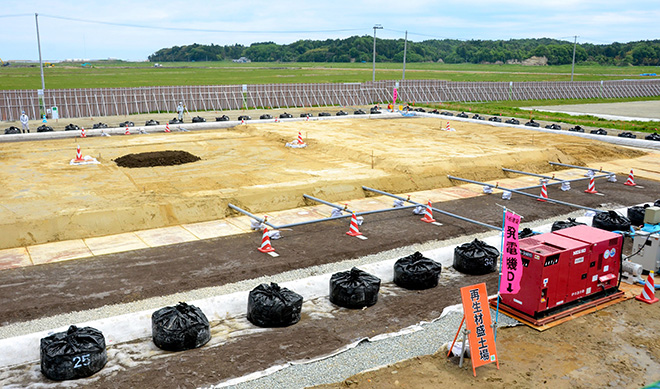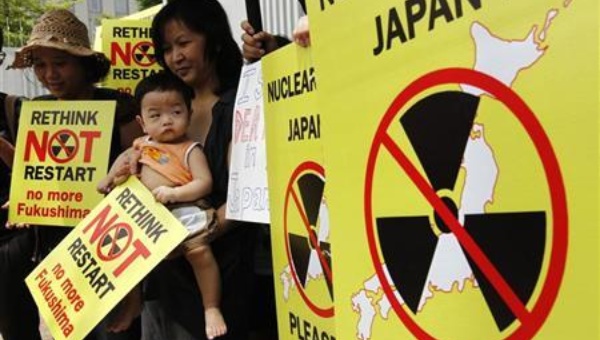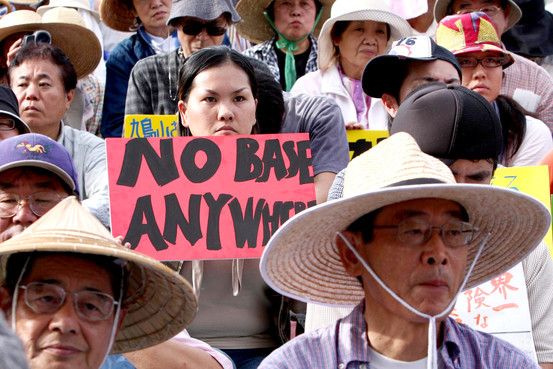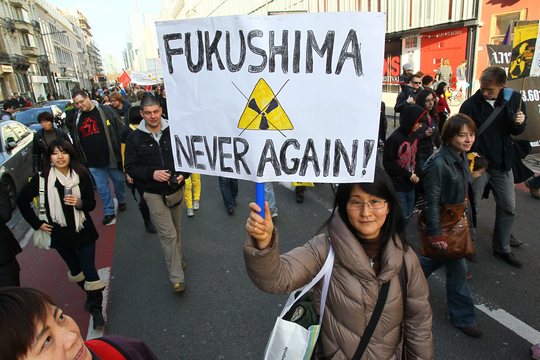From the Open-Publishing Calendar
From the Open-Publishing Newswire
Indybay Feature
On 11th Anniversary of Fukushima No Nukes, No War, US Military Out Of Japan & Okinawa
Date:
Friday, March 11, 2022
Time:
3:00 PM
-
4:00 PM
Event Type:
Protest
Organizer/Author:
No Nukes Action
Location Details:
San Francisco Japanese Consulate
275 Battery St/California St.
275 Battery St/California St.
3/11/22 Friday 100th Action Against The Nukes
On The 11th Anniversary of Fukushima
No NUKES, No WAR, US Military Out Of Japan & Okinawa
Rally At San Francisco Japanese Consulate
Friday March 11, 2022 3:00 PM
San Francisco Japanese Consulate
275 Battery St/California St.
San Francisco
Sponsored by No Nukes Action
Join the Rally and Speak Out/Music/Poetry/Voices
On the 11th anniversary of the Fukushima nuclear explosions, the government has still not removed the melted nuclear rods at the broken plants. There has been no decontamination and TEPCO which has been taken over by the government is plannng to release more than 1 million tons of radioactive water In tanks surrounding the reactors.
The government continues to pressurize the refugees who left the area to return despite the fact that it still remains contaminated and dangerous. There are still tens of thousands of bags of radioactive waste that continue to remain throughout the prefecture with no place to go.
On this 11tth anniversary the Japanese government along with the US government are spending billions for preparation of war and a clear violation of Article 9 of the Constitution which forbids offensive wars and yet this is what the governnment is now violating.
The US with the support of the Japanese government is continuing to build bases in Okinawa and terrorizing the poplulation with jet and helicopter noise pollution, spread of covid by US military personell and rapes and attacks on Okinawan people.
WE demand that there be no restarting of nuclear plants in Japan, full compensation for the refugees and for government officials to be held accountable for this dangerous condition still facing the Japanese people and the world.
Speak-out In Stop The Restarting Of The Nuke Plants
Defend The Refugees of Fukushima
Don’t Dump The Radioactive Water In The Pacific Ocean
No NUKES, No WAR, US Military Out Of Japan & Okinawa
Friday March 11, 2022 3PM
San Francisco Japanese Consulate
275 Battery St/California St.
San Francisco
No Nukes Action
http://nonukesaction.wordpress.com/
Evening On Line Event 3/11/22
Mothers For Peace
March 11, 2022, marks the 11th anniversary of the Fukushima disaster.
Join our webinar on March 11, 6-7pm PST
Fukushima: 11 years after the triple meltdown
Our featured speaker is Japanese journalist Hiroko Aihara who will be speaking
on the current state of the Fukushima evacuees, the government’s plan to
release irradiated water into the ocean, and what actions we can take.
Please register in advance for this event:
https://us02web.zoom.us/meeting/register/tZcudequqz0oGdNnRbckyKXrAM4mu
PQqioCt
After registering, you will receive a confirmation email containing information about joining the meeting.
On The 11th Anniversary of Fukushima
No NUKES, No WAR, US Military Out Of Japan & Okinawa
Rally At San Francisco Japanese Consulate
Friday March 11, 2022 3:00 PM
San Francisco Japanese Consulate
275 Battery St/California St.
San Francisco
Sponsored by No Nukes Action
Join the Rally and Speak Out/Music/Poetry/Voices
On the 11th anniversary of the Fukushima nuclear explosions, the government has still not removed the melted nuclear rods at the broken plants. There has been no decontamination and TEPCO which has been taken over by the government is plannng to release more than 1 million tons of radioactive water In tanks surrounding the reactors.
The government continues to pressurize the refugees who left the area to return despite the fact that it still remains contaminated and dangerous. There are still tens of thousands of bags of radioactive waste that continue to remain throughout the prefecture with no place to go.
On this 11tth anniversary the Japanese government along with the US government are spending billions for preparation of war and a clear violation of Article 9 of the Constitution which forbids offensive wars and yet this is what the governnment is now violating.
The US with the support of the Japanese government is continuing to build bases in Okinawa and terrorizing the poplulation with jet and helicopter noise pollution, spread of covid by US military personell and rapes and attacks on Okinawan people.
WE demand that there be no restarting of nuclear plants in Japan, full compensation for the refugees and for government officials to be held accountable for this dangerous condition still facing the Japanese people and the world.
Speak-out In Stop The Restarting Of The Nuke Plants
Defend The Refugees of Fukushima
Don’t Dump The Radioactive Water In The Pacific Ocean
No NUKES, No WAR, US Military Out Of Japan & Okinawa
Friday March 11, 2022 3PM
San Francisco Japanese Consulate
275 Battery St/California St.
San Francisco
No Nukes Action
http://nonukesaction.wordpress.com/
Evening On Line Event 3/11/22
Mothers For Peace
March 11, 2022, marks the 11th anniversary of the Fukushima disaster.
Join our webinar on March 11, 6-7pm PST
Fukushima: 11 years after the triple meltdown
Our featured speaker is Japanese journalist Hiroko Aihara who will be speaking
on the current state of the Fukushima evacuees, the government’s plan to
release irradiated water into the ocean, and what actions we can take.
Please register in advance for this event:
https://us02web.zoom.us/meeting/register/tZcudequqz0oGdNnRbckyKXrAM4mu
PQqioCt
After registering, you will receive a confirmation email containing information about joining the meeting.
For more information:
http://nonukesaction.wordpress.com/
Added to the calendar on Wed, Mar 2, 2022 10:05AM
Add Your Comments
Comments
(Hide Comments)

Fukushima Radioactive waste stuck at 830 sites with nowhere to go
THE ASAHI SHIMBUN
March 3, 2022 at 18:55 JST
Photo/Illutration
A temporary storage site for contaminated soil resulting from the 2011 Fukushima nuclear disaster. The bags of radioactive waste are due to be shipped to an interim storage facility. The photo was taken in February. (Yukiko Sakamoto)
Vast quantities of topsoil collected during decontamination work after the 2011 Fukushima nuclear disaster are stuck in limbo at hundreds of sites with no early prospect of being shipped to interim storage facilities ahead of a government-set deadline.
The soil is being kept “temporarily” at 830 locations in six municipalities in Fukushima Prefecture.
The city of Koriyama has 582 sites containing about 6,000 cubic meters of waste, followed by Fukushima with about 2,000 cubic meters at 200 locations.
Significant delays are expected in shipping the soil even though the government had planned to complete the operation by the end of this month as required by law.
The volume of contaminated soil and other radioactive materials awaiting shipment totals 8,460 cubic meters, which is the equivalent of 130 trucks each weighing 10 tons.
A key reason for the delay is that new houses were built on land where contaminated soil was buried as negotiations over storage sites in many communities dragged on. This accounts for about 50 percent of the cases cited by municipalities in a survey by the prefectural government last September.
About 30 percent of cases resulted from the refusal of landowners to bear the transportation costs, while about 10 percent are due to an inability by the authorities to contact the landowners.
As time passed, ownership of land tracts changed due to sales transactions and inheritance issues. Some landowners had no idea their plots contained radioactive material.
Tokyo Electric Power Co., operator of the crippled Fukushima No. 1 nuclear plant, shouldered the cost of the cleanup.
But the owners of the homes in question are obliged to pick up the tab for relocating so that the buried waste can be removed, according to the Environment Ministry.
Officials in the six local governments said the radiation levels at the 830 sites pose no health hazard as the readings were below 0.23 microsieverts per hour, the threshold for the need to decontaminate.
Decontamination work in affected communities in the prefecture wound up by March 2018.
The waste from those operations is required by law to be shipped outside the prefecture for final disposal by 2045.
Until then, the interim storage facility is all that is available.
The central government and Fukushima prefectural authorities have been locked in talks for the past 18 months on what to do with contaminated soil that cannot be moved any time soon.
The Environment Ministry called on local governments to continue managing contaminated soil that is deemed difficult to move in line with a directive issued in December 2020 that made it their responsibility.
The special measures law concerning the handling of radioactive materials stipulates that municipalities, which oversaw the cleanup, are responsible for managing the contaminated materials.
But the ministry’s directive upset local governments, which operate with limited manpower and funds.
Officials with the Fukushima and Sukagawa city governments held informal talks with the ministry last October to request that the central government collect, manage and transport the contaminated soil.
“We cannot manage these sites forever as the number of our employees is dwindling,” one official said.
Kencho Kawatsu, who chairs a committee with oversight for the environmental safety of the interim storage facility, underlined the need for the central and Fukushima prefectural governments to share in the responsibility for managing the temporary storage sites with municipalities.
“If the radioactive soil is scattered, it could fuel rumors that prove harmful to Fukushima municipalities,” said Kawatsu, a guest professor of environmental policy and radiation science at Fukushima University.
He suggested centralizing data on the issue to prevent such an occurrence.
THE ASAHI SHIMBUN
March 3, 2022 at 18:55 JST
Photo/Illutration
A temporary storage site for contaminated soil resulting from the 2011 Fukushima nuclear disaster. The bags of radioactive waste are due to be shipped to an interim storage facility. The photo was taken in February. (Yukiko Sakamoto)
Vast quantities of topsoil collected during decontamination work after the 2011 Fukushima nuclear disaster are stuck in limbo at hundreds of sites with no early prospect of being shipped to interim storage facilities ahead of a government-set deadline.
The soil is being kept “temporarily” at 830 locations in six municipalities in Fukushima Prefecture.
The city of Koriyama has 582 sites containing about 6,000 cubic meters of waste, followed by Fukushima with about 2,000 cubic meters at 200 locations.
Significant delays are expected in shipping the soil even though the government had planned to complete the operation by the end of this month as required by law.
The volume of contaminated soil and other radioactive materials awaiting shipment totals 8,460 cubic meters, which is the equivalent of 130 trucks each weighing 10 tons.
A key reason for the delay is that new houses were built on land where contaminated soil was buried as negotiations over storage sites in many communities dragged on. This accounts for about 50 percent of the cases cited by municipalities in a survey by the prefectural government last September.
About 30 percent of cases resulted from the refusal of landowners to bear the transportation costs, while about 10 percent are due to an inability by the authorities to contact the landowners.
As time passed, ownership of land tracts changed due to sales transactions and inheritance issues. Some landowners had no idea their plots contained radioactive material.
Tokyo Electric Power Co., operator of the crippled Fukushima No. 1 nuclear plant, shouldered the cost of the cleanup.
But the owners of the homes in question are obliged to pick up the tab for relocating so that the buried waste can be removed, according to the Environment Ministry.
Officials in the six local governments said the radiation levels at the 830 sites pose no health hazard as the readings were below 0.23 microsieverts per hour, the threshold for the need to decontaminate.
Decontamination work in affected communities in the prefecture wound up by March 2018.
The waste from those operations is required by law to be shipped outside the prefecture for final disposal by 2045.
Until then, the interim storage facility is all that is available.
The central government and Fukushima prefectural authorities have been locked in talks for the past 18 months on what to do with contaminated soil that cannot be moved any time soon.
The Environment Ministry called on local governments to continue managing contaminated soil that is deemed difficult to move in line with a directive issued in December 2020 that made it their responsibility.
The special measures law concerning the handling of radioactive materials stipulates that municipalities, which oversaw the cleanup, are responsible for managing the contaminated materials.
But the ministry’s directive upset local governments, which operate with limited manpower and funds.
Officials with the Fukushima and Sukagawa city governments held informal talks with the ministry last October to request that the central government collect, manage and transport the contaminated soil.
“We cannot manage these sites forever as the number of our employees is dwindling,” one official said.
Kencho Kawatsu, who chairs a committee with oversight for the environmental safety of the interim storage facility, underlined the need for the central and Fukushima prefectural governments to share in the responsibility for managing the temporary storage sites with municipalities.
“If the radioactive soil is scattered, it could fuel rumors that prove harmful to Fukushima municipalities,” said Kawatsu, a guest professor of environmental policy and radiation science at Fukushima University.
He suggested centralizing data on the issue to prevent such an occurrence.
For more information:
https://www.asahi.com/ajw/articles/14562951
We are 100% volunteer and depend on your participation to sustain our efforts!
Get Involved
If you'd like to help with maintaining or developing the website, contact us.
Publish
Publish your stories and upcoming events on Indybay.
Topics
More
Search Indybay's Archives
Advanced Search
►
▼
IMC Network







